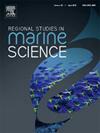A pilot study of fish biodiversity with a highlight of chondrichthyans in Hong Kong waters using environmental DNA metabarcoding
IF 2.1
4区 环境科学与生态学
Q3 ECOLOGY
引用次数: 0
Abstract
Assessing marine fish biodiversity, particularly high trophic level and conservation value species like chondrichthyans (sharks, rays, and skates), is crucial for evaluating the health of local fisheries and the sustainability of coastal ecosystems. Hong Kong boasts a diverse coastal ecosystem and harbors a wide variety of marine fish species. Yet traditional fish survey methods often fall short of efficiently assessing local fish diversity. In this study, we employed the non-invasive environmental DNA (eDNA) method, to evaluate the overall fish diversity in Hong Kong, with a focus on chondrichthyans. We collected full-depth water samples from the eastern, southern, and western waters of Hong Kong. The primer set Elas12S was used to target chondrichthyans, while 12S_V5 was used to screen for all fish species. We successfully detected five chondrichthyan species (Scoliodon laticaudus, Scoliodon macrorhynchos, Gymnura japonica, Telatrygon zugei, and Hemitrygon bennettii), two of which are Near Threatened and two are Vulnerable according to the IUCN Red List. The eDNA data unveiled 136 fish species from 54 families within Hong Kong’s coastal waters, with Mugil cephalus exhibiting the highest level of abundance. The indicator species utilized to assess environmental conditions differed substantially across distinct hydrographic zones. Our findings in this eDNA pilot study conducted in Hong Kong demonstrate that the eDNA method can be applied to detect targeted, vulnerable or near-threatened fish species, such as sharks and rays. Furthermore, this rapid detection methodology could have valuable applications for long-term biodiversity monitoring and marine conservation. To enhance the eDNA method and its accuracy in species identification, we recommend establishing a comprehensive reference database of DNA barcodes for local fish species and investigating appropriate sampling efforts in the highly diverse waters of Hong Kong.
利用环境DNA元条形码对香港水域鱼类生物多样性进行初步研究,重点是软骨鱼
评估海洋鱼类的生物多样性,特别是高营养级和具有保护价值的物种,如软骨鱼(鲨鱼、鳐鱼和鳐鱼),对于评估当地渔业的健康和沿海生态系统的可持续性至关重要。香港拥有多样化的海岸生态系统,并拥有种类繁多的海洋鱼类。然而,传统的鱼类调查方法往往不能有效地评估当地鱼类的多样性。在这项研究中,我们采用非侵入性环境DNA (eDNA)方法,对香港鱼类的整体多样性进行了评估,重点是软骨鱼。我们在香港东部、南部和西部水域采集了全深度的水样。引物组Elas12S用于靶定软骨鱼,引物组12S_V5用于筛选所有鱼类。我们成功检测到5种软骨鱼(脊椎侧裂鱼、大脊骨侧裂鱼、日本Gymnura japonica、zugei Telatrygon和Hemitrygon bennettii),其中2种属于IUCN红色名录的近危物种,2种属于易危物种。eDNA数据显示,香港沿海水域有54科136种鱼类,其中大头Mugil cephalus的丰度最高。用于评估环境条件的指示物种在不同的水文带之间有很大差异。我们在香港进行的这项eDNA试点研究的结果表明,eDNA方法可以应用于检测目标,脆弱或接近威胁的鱼类,如鲨鱼和鳐鱼。此外,这种快速检测方法在长期生物多样性监测和海洋保护方面具有重要的应用价值。为了提高eDNA方法在物种鉴定方面的准确性,我们建议为本地鱼类建立一个全面的DNA条形码参考数据库,并在香港高度多样化的水域进行适当的取样研究。
本文章由计算机程序翻译,如有差异,请以英文原文为准。
求助全文
约1分钟内获得全文
求助全文
来源期刊

Regional Studies in Marine Science
Agricultural and Biological Sciences-Ecology, Evolution, Behavior and Systematics
CiteScore
3.90
自引率
4.80%
发文量
336
审稿时长
69 days
期刊介绍:
REGIONAL STUDIES IN MARINE SCIENCE will publish scientifically sound papers on regional aspects of maritime and marine resources in estuaries, coastal zones, continental shelf, the seas and oceans.
 求助内容:
求助内容: 应助结果提醒方式:
应助结果提醒方式:


